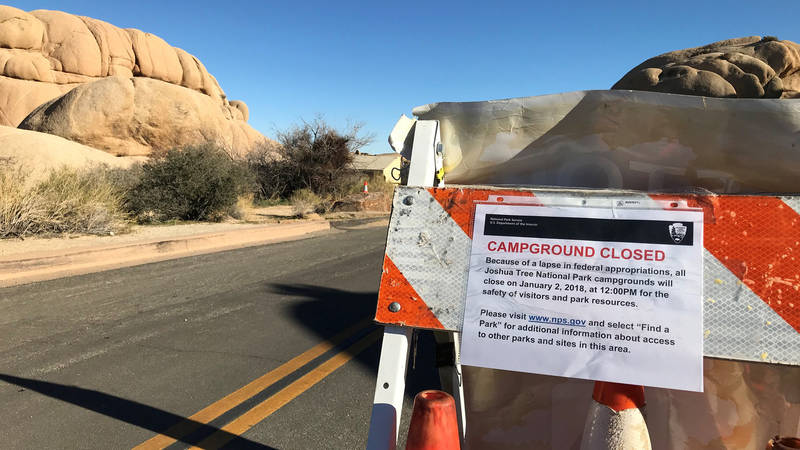Unsustainable tactics are keeping some national parks open during the federal government shutdown. What happens when those tactics are no longer workable?
During the federal government shutdown, the Trump administration has mandated that national parks keep their gates open and many areas of parks accessible to the public, despite only having a skeleton crew of park staff on the ground to protect irreplaceable resources and keep visitors safe. As a result of the shutdown, more than 9,000 park staff are furloughed and many parks are relying on the saving grace of state assistance, volunteer groups or entrance and recreational fees normally tagged for other purposes.
But parks have been hanging by a thread — and as the shutdown drags on, these substitute revenue sources are starting to dry up.
State Support
A provision included in the Trump administration’s National Park Service shutdown contingency plan allows parks to enter into agreements with states, Native American tribes, local governments or other groups to keep park sites open during the shutdown. Local governments and businesses know from experience that government shutdowns can devastate their economies, and many have decided to step in to help mitigate the problem. Several states, including Colorado, Utah, Tennessee and West Virginia are keeping some of their most popular national parks operational while the federal government remains shut down.
The federal government has shut down. Unfortunately, our parks should too.
Tell Interior Secretary Doug Burgum to protect precious park wildlife, historic artifacts and park visitors by closing parks until the shutdown ends.
Take ActionThe State of Tennessee along with Sevier County, Blount County, the Eastern Band of Cherokee Indians, the cities of Gatlinburg, Pigeon Forge and Sevierville joined Friends of the Smokies to provide nearly $62,000 per day to keep the nation’s most-visited national park, Great Smoky Mountains open and fully operational during one of the park’s busiest tourist seasons. While this agreement has allowed the park to continue welcoming visitors, the agreement only provides funding through Nov. 2. After that, how the park will be funded should the shutdown continue remains unclear.
West Virginia’s governor also signed a donation agreement at the start of the shutdown to keep the state’s national parks fully operational. While the original agreement of nearly $100,000 was set for two weeks, Gov. Patrick Morrisey has since extended the financial support until the end of the month.
As it did during the last shutdown, the state of Utah has stepped in to keep visitor centers funded and open at the state’s so-called Mighty 5 national parks — Arches, Bryce Canyon, Canyonlands, Capitol Reef and Zion — as well as Cedar Breaks National Monument. This step costs roughly $8,000 per day.
And most recently, Colorado’s Gov. Jared Polis announced the state will provide funds to keep two visitor centers open at Rocky Mountain National Park — Beaver Meadows and Kawuneeche — until Oct. 30, with the option to extend the funding if the government remains shut down. Colorado estimates the cost at approximately $3,200 per day.
Although state donations help keep some parks operating, they provide only a small portion of the funding required to fully staff them and safeguard their natural resources.
NPCA understands states wanting to step in, given that parks generate tens of millions of dollars in visitor spending every day. But keeping parks open and protected is a federal responsibility, and Congress and the administration must uphold it.
Park Partner Groups
And the same goes for the dedicated partner groups that support hundreds of national parks across the country. Park partners provide invaluable support to our national parks, but expecting them to fill the gap left by the federal government is both unfair and unsustainable.
Friends of Vicksburg National Military Park in Mississippi is using donations — $2,000 per day — to keep the site open during the shutdown. Friends of Acadia National Park in Maine set up an online voluntary donation system to help make up for the millions in lost revenue the park typically collects in entrance fees in October. And Zion Forever Project has also been instrumental in keeping Zion National Park in Utah open by funding some essential park operations, such as collecting trash, maintaining restrooms and managing volunteers to provide important park and safety information to visitors. The partner group is extending their assistance even further, supporting furloughed park staff by raising donations and supplies to help these dedicated public servants make ends meet until the government reopens.
Sequoia Parks Conservancy decided not to step in to keep California’s Sequoia and Kings Canyon National Parks open this time. “Sometimes the most responsible action is to stand ready, not stand open,” said Executive Director Savannah Boiano.
She was newly appointed in her role during the 2018-2019 government shutdown when the conservancy’s leadership decided to pay to keep visitor centers and other select services open from Thursdays through Sundays. “In the end, no one won,” Boiano said. The organization did not receive additional funding to cover its costs, the stewardship impact was unclear for visitors, and some park staff expressed frustration that the Conservancy kept services open while so many park rangers and experts were furloughed at home. This time, the conservancy plans to conserve its own resources so it can be ready to serve the parks when they reopen.
Many partners have made the difficult decision to divert limited funds from critical projects not funded by the government to help keep their parks operating. But as the shutdown continues, they may soon be unable to continue providing support at all. Depleting these philanthropic funds means our parks will have fewer resources for projects and programs the rest of the year. Their funding is meant to supplement federal resources, not replace them.
Fees
With federal funding cut off during the shutdown, Interior Secretary Burgum has urged national parks to dip into the Park Service’s entrance and recreation fee accounts to cover operating expenses like staffing, sanitation and public safety. But the fee fund was never set up to function as a rainy-day reserve for the Park Service. Rather, it is to be used for projects that enhance visitor experiences, such as addressing maintenance needs, providing additional visitor services, and improving opportunities for recreation and the viewing of wildlife.
Fewer than half of the 433 national park sites charge entrance or recreation fees. Those that do retain 80% of the money for on-site projects, with the remaining 20% distributed to parks that collect little or no fees.
The Park Service collects approximately $350 million each year in fees. Dry Tortugas National Park used fee dollars to restore coral reef habitat for the health of the ecosystem but also improve fishing and snorkeling opportunities. Wind Cave National Park used fee dollars to construct fencing to allow visitors to safely view bison and elk herds. Shiloh National Military Park installed three new restrooms for visitors at the Shiloh Battlefield. More projects can be found on the Park Service’s Your Fee Dollars at Work webpage.
Diverting these fee dollars during a shutdown effectively reduces parks’ overall budgets. On top of that, parks are unable to collect fees while the government is closed, compounding the loss. NPCA estimates that national parks lose roughly $1 million in fee revenue every day the government remains shut down.
Diverting fee dollars during a shutdown effectively reduces parks’ overall budgets.
In the last Trump administration shutdown in 2018, as parks were experiencing impacts like overflowing trash cans, uncleaned restrooms and physical harm to park resources, Interior Secretary David Bernhardt instructed park staff to use fee dollars to mitigate harm and keep gates open.
NPCA has long maintained that using recreation and fee revenue to keep national parks operational during a government shutdown is unlawful. And in September 2019, the Government Accountability Office (GAO) supported our assertion, concluding that the actions by the Department of the Interior violated appropriations law and the Antideficiency Act. The GAO report stated that the action by the Interior “tears at the very fabric of Congress’s constitutional power of the purse,” and that they “will consider such violations in the future to be knowing and willful violations of the Act.”
Stay On Top of News
Our email newsletter shares the latest on parks.
Using fees as operational funds is a workaround that only allows for skeleton staffing, just enough to give the appearance of operations without actually protecting visitors or park resources. Experience has shown that this model fails. Pulling from these accounts means deferred maintenance, visitor programs, road repairs and other critical improvements are put on the back burner. Diverting essential fee dollars away from these projects and services not only hurts parks, but it also hurts visitors’ experience and safety.
The solution is clear: Secretary Burgum must close parks until the shutdown ends. Join us in calling on the administration to protect park wildlife, historic artifacts, fragile landscapes, and visitors by doing what’s right.
About the author
-
 Emily Douce Deputy Vice President, Government Affairs
Emily Douce Deputy Vice President, Government AffairsAs the Deputy Vice President for Government Affairs, Emily Douce helps manage the department and advocates for additional funding for national parks, both through appropriations and supplementary sources.
-
General
-
- Parks:
- Acadia National Park
- Arches National Park
- Bryce Canyon National Park
- Canyonlands National Park
- Cedar Breaks National Monument
- Dry Tortugas National Park
- Great Smoky Mountains National Park
- Kings Canyon National Park
- New River Gorge National Park & Preserve
- Rocky Mountain National Park
- Sequoia National Park
- Shiloh National Military Park
- Vicksburg National Military Park
- Wind Cave National Park
- Zion National Park
-
-
Issues


